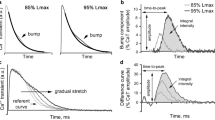Abstract
In human heart failure, an increase in frequency of stimulation is followed by a reduced force of contractionin vivo andin vitro. The present study aimed to investigate whether a different origin of the myocardial sample or pretreatment with the cardioprotective agent 2,3-butanedione-monoxime (BDM) influences the force-frequency-relationship in electrically driven muscle strips taken from failing and nonfailing human myocardium. With as well as without pretreatment with BDM, the altered force-frequency-relationship in failing compared to nonfailing human ventricular myocardium can be observed. The effectiveness and the potency to increase force of contraction following an increase in frequency of stimulation was significantly higher in atrial than in ventricular myocardium in nonfailing and failing tissue. The different observations in atrial and ventricular myocardium provide evidence for functionally relevant differences in the electromechanical coupling between the human atrial and ventricular myocardium.
Similar content being viewed by others
References
Bodwitch HP: Über die Eigentümlichkeiten der Reizbarkeit, welche die Muskelfasern des Herzens zeigen. Berl Sächs Ges (Akad) Wiss 652–689, 1871
Buckley NM, Penefsky ZJ, Litwak RS: Comparative force-frequency relationship in human and other mammalian ventricular myocardium. Pflügers Arch 332: 259–270, 1972
Mulieri LA, Hasenfuss G, Leavitt B, Allen PD, Alpert NR: Altered myocardial force-frequency relation in human heart failure. Circulation 85: 1743–1750, 1992
Schwinger RHG, Böhm M, Erdmann E: Inotropic and lusitropic dysfunction in myocardium from patients with dilated cardiomyopathy. Am Heart J 123: 116–128, 1992
Feldman MD, Alderman JD, Aroesty JM, Royal HD, Ferguson JJ, Owen RM, Grossman W, McKay RG: Depression of systolic and diastolic myocardial reserve during atrial pacing tachycardia in patients with dilated cardiomyopathy. J Clin Invest 82: 1661–1669, 1988
Mulieri LA, Hasenfuss G, Ittleman F, Blanchard EM, Alpert NR: Protection of human left ventricular myocardium from cutting injury with 2,3-butanedione monoxime. Circ Res 65: 1441–1444, 1989
Li T, Sperelakis N, Teneick RE, Solaro RJ: Effects of diacetyl monoxime on cardiac excitation-contraction coupling. J Pharmacol Exp Ther 232: 688–695, 1992
Coulombe A, Lefevre IA, Deroubaix E, Thuringer D, Coraboeuf E: Effect of 2,3-butanedione 2 monoxime on slow inward and transient outward currents in rat ventricular myocytes. J Mol Cell Cardiol 22: 921–932, 1990
Sada H, Sada S, Sperelakis N: The calcium channel agonist, Bay K-8644, antagonizes effects of diacetyl monoxime on cardiac tissue. Can J Physiol Pharmacol 63: 1267–1270, 1985
Mörner SEJN, Wohlfart B: The action of 2,3-butanedionemonoxime on the inotropic state in guinea-pig myocardium. Acta Physiol Scand 142: 211–219, 1991
Gwathmey JK, Warren SE, Briggs GM, Copelas L, Feldman MD, Phillips PJ, Callaham M, Schoen FJ, Grossman W, Morgan JP: Diastolic dysfunction in hypertrophic cardiomyopathy. J Clin Invest 87: 1023–1031, 1991
Wallenstein S, Zucker CL, Fleiss JL: Some statistical methods useful in circulation research. Circ Res 47: 1–9, 1980
Schwinger RHG, Böhm M, Koch A, Erdmann E: Beneficial cardioprotective actions of BDM on human myocardium. Eur Heart J 13: P762, 1992
Blanchard EM, Smith GL, Allen DG, Alpert NR: The effects of 2,3-butanedione monoxime on initial heat, tension, and aequorin light output of ferret papillary muscles. Pflügers Arch 416: 219–221, 1990
Schwinger RHG, Koch A, Erdmann E: Einfluß von Butandionmonoxim auf die Kontraktionskraft des menschlichen Herzens. Z Kardiol 81: P286, 1992
Finkel MS, Patterson RE, Roberts WC, Smith TD, Keise HR: Calcium channel binding characteristics in the human heart. Am J Cardiol 62: 1281–1284, 1988
Rasmussen RP, Minobe W, Bristow MR: Calcium antagonist binding sites in failing and nonfailing human ventricular myocardium. Biochem Pharmac 39: 691–696, 1990
Beuckelmann DJ, Näbauer M, Erdmann E: Characteristics of calcium-current in isolated human ventricular myocytes from patients with terminal heart failure. J Mol Cell Cardiol 23: 929–937, 1991
Escade D, Coulombe A, Faivre JF, Coraboeuf E: Characteristics of the time-dependent slow inward current in adult human atrial single myocytes. Mol Cell Cardiol 18: 547–551, 1986
Beuckelmann DJ, Näbauer M, Erdmann E: Intracellular calcium handling in isolated ventricular myocytes from patients with terminal heart failure. Circulation 85: 1046–1055, 1992
Gwathmey JK, Hajjar RJ, Solaro RJ: Contractile deactivation and uncoupling of crossbridges. Circ Res 69: 1280–1292, 1991
Wankerl M, Böhm M, Morano I, Rüegg JC, Eichhorn M, Erdmann E: Calcium sensitivity and myosin light chain pattern of atrial and ventricular skinned cardiac fibers from patients with various kinds of cardiac disease. J Mol Cell Cardiol 22: 1425–1438, 1990
Morano I, Beltz C, Wojciechowski, Rüegg JC: Modulation of crossbridge kinetics by myosin isoenzymes in skinned human heart fibers. Circ Res 68: 614–618, 1991
Schwinger RHG, Böhm M, Pieske B, Erdmann E: Different β-adrenoceptor-effector coupling in human ventricular and atrial myocardium. Eur J Clin Invest 21: 443–451, 1991
Solaro RJ: Myosin and why hearts fail. Circulation 85: 1945–1946, 1992.
Author information
Authors and Affiliations
Rights and permissions
About this article
Cite this article
Schwinger, R.H.G., Böhm, M., Koch, A. et al. Force-frequency-relation in human atrial and ventricular myocardium. Mol Cell Biochem 119, 73–78 (1993). https://doi.org/10.1007/BF00926856
Issue Date:
DOI: https://doi.org/10.1007/BF00926856




